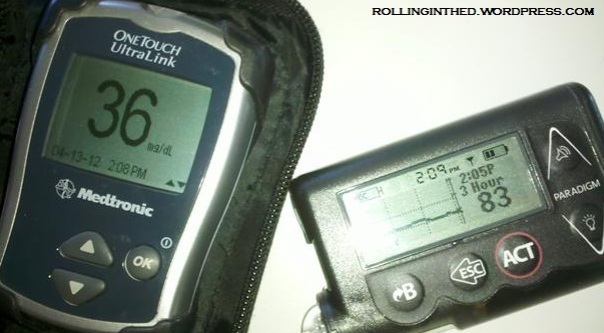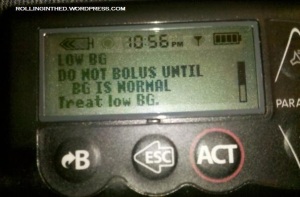The “rule of 15” is so 15 years ago
Someone, somewhere, came up with this so-called “rule of fifteen.” If your blood sugar is low, treat it with a fifteen-carb snack, then patiently watch the second-hand spin ’round the clock fifteen times before testing again.
You have got to be kidding me. This rule is so flawed, that even the glucose tablet confectioneries don’t make products which comply. (Speaking of confectioneries, I went to college down the street from Just Born, makers of delicious [I’m told] candies such as Mike & Ike and Marshmallow Peeps. The place itself looks like a hospital, and it took years to realize what really went on in that building! Now I hear that Mike and Ike might be splitting up. So sad.)
Back on topic. With no individual customization whatsoever, or no evaluation of just how low a person might be, fifteen carbs will always do the trick. And if it doesn’t. try again.
Well, when my blood sugar hit 36 mg/dl (2.0 mmol/L) last week, I knew 15 carbs wouldn’t do the job. No way. Not if I was that low.
So I had four glucose tablets: 16 carbs. Feeling a bit unsatisfied and unconvinced by the tropically-flavored chalk, I also had an orange. And a handful of almonds (because they were there, and I really like almonds), and some raisins. Finally, I washed it all down with a Diet Coke. Because even if I’m indulging on carbs (whether treating or just cheating), my commitment to Diet Coke is unbreakable.
I spent the rest of the evening rage-bolusing against the 300 milligrams of glucose coursing through every deciliter of my bloodstream. I knew it would happen, but I just didn’t want to drop down to a 35.
(By the way, that 36 came after vacuuming my car interior, because cleaning is almost always the first sign of hypoglycemia. Despite the slight dizziness and sweat dripping down my back, the absense of a down-arrow on my pump/CGM made me believe everything was alright. As I discussed on Monday, that was not the case.)
What should I have done? Well, that little back box with the tiny motor and the Energizer battery that stays clipped to my belt has a whole bunch of ratios programmed into its Bolus Wizard. Carb ratio: 1 unit of insulin is needed for 9 carbs of food. Sensitivity: 1 unit of insulin will lower my BG by 60 mg/dl. Therefore, 9 carbs will yield a 60 mg/dl. Factor the denominator and carry the one, and you learn that 1 carb should give me a 6.6 mg/dl bump.
No way in hell am I going to do this math when my BG is normal, much less when it’s 36. But my pump could’ve done that, it’s really good at math. It could’ve told me that, to get back to normal range, 10 carbs would do the trick [hard to believe, but the numbers don’t lie]. But no, it just told me that it wouldn’t be a good idea to bolus right now, and that I should do something about my low sugar. Gee, thanks.
Now I know why PWDs always, always, ALWAYS overtreat lows. It’s that damned Rule of Fifteen. It must harken back to the days of Ye Olde Exchange Diet, where every starch and fruit exchange were measured in intervals of 15, and everyone’s suggested insulin needs were 1 unit per exchange/15 carbs.
Posted on April 18, 2012, in Diabetes, Insulin pump and tagged hypo, Outdated. Bookmark the permalink. 9 Comments.



You used to not be able to bypass the low BG warning on the MM pump either so you would have to lie to it about what your BG was. At least now you can clear that warning and enter the carbs you’ve even to see how many of them are over the number you need for treatment.
LikeLike
If I recall correctly, the old BD glucose tablets (remember the white chalky squares?) had 5 grams of carbs. Maybe the new companies decided the old 15 grams rule didn’t apply but the rule never went away! I try to treat according to BS, but sometimes you just feel like crap and have to eat everything in site!
LikeLike
I’m so right there with ya … I always have good intentions of just eating my 3-4 glucose tabs and waiting .. and when I do have the patience to wait, it will usually work. But more times than not, I need to fix it – NOW. So I’ll eat the tabs.. Then maybe some fruit. And whatever else I can easily get my hands on. And then like you said, you spend a few hours trying to get back down. It’s a mean, vicious cycle.
It’s a mean, vicious cycle.
And Kelly – I was just talking about those square glucose tabs the other day. That’s old school right there. lol
And I’m always bad about still bolusing even when my pump gives me that message. Only if I’m low right at mealtime. If I have food in front of me, especially, I don’t want to bring up the BG then finally eat my now cold food.
LikeLike
If it’s mealtime, I’ll usually either give myself a 30- or 60-minute square-wave/extended bolus (since there is no “delayed bolus” option on the pump). Sometimes, I’ll start eating, and then 20 or 30 minutes later, give the bolus and manually enter the really-low-BG (which is no longer accurate) so the negative-correction goes in effect.
Of course I remember the BD tabs! I’m not sure which was worst about those things: the size, the hardness (you need some strong teeth to bite into them!), or the packaging (which tripled the volume of stuff you need to carry around).
LikeLike
Okay, I’m not a pumper. So I have to ask, how does your pump know your BG? I thought they didn’t make a CGM pump combo? Confused! Sorry.
And as far as the 15 minute rule goes, I think our human survival instincts kick in. If I have time, I will wait 15 minutes and check again, but most of the time I eat whatever I can as fast as I can. I think that’s us in survival mode!
LikeLike
Sorry, I kind of took a few things for granted. The One Touch Ultralink has a wireless radio link to the pump, so every time I test, it beams the result over. It can then use that to recommend insulin needs, or just store it in memory to be downloaded later.
The pump also has all kinds of settings programmed in, like how much 1 unit of insulin will lower my BG, or how many carbs 1 unit will cover. So if I’m, say, 200 and my target is 100, the pump will realize I need to lower my blood sugar by 100 (1.67 units in addition to what’s needed to cover the food I’m about to eat) and recommend the proper amount of insulin after I tell it how many carbs I’m eating.
Similarly, if I’m 60 before eating and my target is 100, it will do the math and subtract 0.67 units from the insulin needed to cover the food, since I’m already too low. There are warnings that need to be bypassed in order to do this, though, as Sara described earlier.
LikeLike
Awesome. Thank you for the clarification!
LikeLike
Pingback: Do as I say, not as I do « Rolling in the D
Pingback: How to build a better insulin pump | Rolling in the D